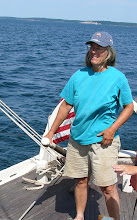photo of my good friend Roland Micklem on his Mt Top Removal campaign last year- he is now working with Save Seneca Lake (see below)
Media coverage abounds on tar sands crude extraction and hydrofracking of
shale gas and oil over the last few years. There has been far less
coverage on another aspect of the unconventional oil and
gas plays- that of issues associated
with the 'infrastructure' needed to store and transport all that
shale gas and oil and tar sands dilbit.
Spectacular pipeline spills
and lethal railroad accidents have made headlines, and Bill McKibben
rallies the troops in Washington DC to protest the Keystone Pipeline.
But around the Great Lakes region the
quiet and rapid building of storage and transport facilities for
gas and oil goes on with little scientific or engineering study,
minimal regulatory oversight, and little media attention.
On the U.S and Canadian shores of Lake
Ontario, the drinking water supply for nine million Americans and
Canadians, two controversial infrastructure projects have local folks
riled up. The U.S. project is a proposed expansion of shale gas
storage in a salt cavern on the shores of Seneca Lake, largest and
deepest of the eleven Finger Lakes that lie within Lake Ontario's
watershed. The plan by a Texas based company called Crestwood is to
pump pressurized natural gas produced in Pennsylvania into an old
salt mine cavern located in the heart of the New York wine producing
region.
Underground storage of natural gas in
salt domes has a poor track record. A similar storage facility in
2012 located in Bayou Corne Louisiana caved in creating a still
expanding sink hole, while in Kansas in 2001 gas migrated seven miles
underground before emerging from abandoned brine wells and
exploding.The salt caverns by Seneca Lake of interest to Crestwood
include one that experienced a massive cave in back in the 1960s when
it was being used to store LPG.
Dr. Sandra Steingraber, nationally
known activist, biologist, and college professor wrote in an op ed
published on the USA Today website on Oct 21, 2014, “Crestwood has
argued that key data about the structural integrity of these old salt
caverns is proprietary information. Both FERC and Gov. Andrew Cuomo's
Department of Environmental Conservation have complied with this
request for secrecy.”
Though little is known about the
geological integrity and suitability of the proposed storage area, we
do know that salt is already entering Seneca Lake. The lake
has chloride levels two to ten times higher than the other nearby
finger lakes. We also know there is a connection to underground salt
deposits. If a cavern is physically disturbed and or collapses,
storage opponents fear their lake and its important recreational
fisheries could be permanently damaged. And we know that a certain
portion of whatever ends up in Seneca Lake will eventually make its
way to Lake Ontario and the St. Lawrence.Perhaps the lake trout
fishermen could switch to bluefish or flounders.
The other proposed
energy transport infrastructure expansion that is drawing protestors
is on the north shore of Lake Ontario and falls within the
jurisdiction of Canada's National Energy Board which oversees gas and
oil pipelines. A company called Enbridge (which has the dubious
distinction of being responsible for a million gallon spill of toxic
all but impossible to clean up tar sands crude into a tributary of
Lake Michigan after its Line 6B split in 2010,) wants to start
pumping tar sands crude through a similar 40 year old pipeline that
runs along Lake Ontario and the St. Lawrence River. That line built
originally to move less viscous less corrosive imported crude oil
westward.
Though Line 9, aka
the Black Snake to opponents of its “re-purposing”, has not been
newsworthy in the U.S. press, a Chippewa band has managed to get
standing in the Canadian Federal Court of Appeal over treaty
violation issues and has challenged the Energy Board approval.
Enbridge had failed to notify the tribe of the proposed re-purposing
of the old line.
Possibly partly as a response to the tribe's court action the NEB recently told Enbridge that it
needed to install shut off valves at major river crossings and in
other environmentally sensitive areas. The company is appealing,
saying Line 9 is perfectly safe and already has plenty of shut off
valves due to something it calls IVP (Intelligent Valve Placement).
It wants to start pumping tar sands crude through the pipe this year
if it can get around the legal road blocks erected by the Thames
River Chippewas.
The appeal and
legal challenge has, for the moment, has delayed the re-purposing of
Line 9. It may be all that stands between us here on Lake Ontario and
another potential disaster in the form of an impossible to clean up
spill.






